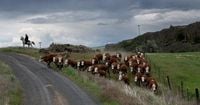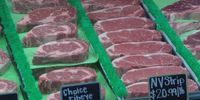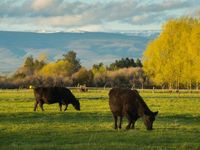Record-high beef prices are sending shockwaves through the American food economy, with both ranchers and consumers feeling the effects of a historic squeeze on cattle supplies. From the rolling pastures of Iowa to the feedlots of Texas and butcher shops in Nevada, the story is the same: fewer cattle, soaring prices, and a market where everyone from cow-calf producers to grocery shoppers is recalibrating their expectations.
According to the latest data from the U.S. Department of Agriculture (USDA), the national beef herd—including calves—plummeted to 94.2 million head by July 2025. That’s the smallest count since the early 1950s, marking a 1% drop from the previous year. The American Farm Bureau Federation (AFBF) confirms that cattle herd sizes are at their lowest levels in 74 years, a staggering statistic that underpins the current market turmoil.
“You kind of have your ups and your downs and it's a roller coaster ride. This particular time it's just straight up,” said Steve Swenka, a fourth-generation rancher in Johnson County, Iowa, to KCRG. Swenka highlighted the unprecedented prices at local auctions: “Some 700-pound steers will bring right around $4 at the local auctions. Finished cattle and bigger cattle too, like 1600-pound cattle, will bring right around $2.60 a pound. That's just unprecedented kind of numbers.”
Jack Field, a rancher near Yakima, Washington, echoed this sentiment, telling The Spokesman-Review, “I got almost $500 more a head this year than last year. It’s just crazy.” Field noted that ranchers are getting record prices for virtually every category of cattle, from calves and feeder cattle to cull cows and even older herd bulls.
The reasons behind this price surge are manifold. Years of drought, particularly since 2022, have ravaged pastures in key beef-producing states like Texas, Oklahoma, and Nebraska. “When a drought hits cattle producers over multiple years, that dries out the grasslands, forces cattle producers to shrink their herds to match the grass they have left to feed,” explained Chad Hart, an agricultural economics professor at Iowa State University, to KCRG. The result? A long-term consolidation in the cattle market and a supply that simply can’t keep up with demand.
Environmental factors aren’t the only culprit. Economic pressures have played a part too. A few years ago, corn prices soared to $7 a bushel, incentivizing many older farmers to convert pastureland to crop ground. As Swenka explained, “What used to be pasture got put into crop ground. Well, I think they're at the age now where those fences aren't going to go back, and the cattle are off the farm for good. So, we're just now replenishing the cattle numbers that kind of disappeared over the last several years.”
For cow-calf producers, these high prices are a boon. “They’re very much in the driver’s seat right now,” said Oklahoma State University economist Derrell Peel to Agri-Pulse. But for others in the supply chain—stockers, backgrounders, and especially packers—the picture isn’t so rosy. Peel described a “margin squeeze,” where input costs are rising faster than output prices, leaving less profit for those further up the chain. JBS, one of the world’s largest beef processors, reported a 5% increase in net revenue in North America during the second quarter of 2025, but CEO Gilberto Tomazoni acknowledged ongoing “pressure from an unfavorable cattle cycle.”
Consumers are feeling the pinch at the checkout counter. Retail ground beef prices hit an average of $6.25 per pound in July 2025, up from $5.49 per pound a year earlier, according to the Bureau of Labor Statistics. That’s an 11% jump for ground beef and nearly 12% for steaks, outpacing overall food inflation nearly fourfold. “No matter where you look in beef, whether it's ground product all the way up to the steaks, you're seeing that same price pressure,” Hart pointed out.
Yet, despite sticker shock, Americans haven’t turned away from beef. “Consumers are consistently buying beef. With the short supply, that puts the folks selling the product in a good sales position,” Field observed. Swenka added, “The consumers know that prices are getting a little high, but they're still willing to pay for the quality that they're receiving. On our end, that's very encouraging.” Michael Gunther, head of insights at Consumer Edge, told The Spokesman-Review that “higher prices don’t seem to have put too much of a dent into those trends yet.”
But how long can this last? Both farmers and industry experts agree that rebuilding cattle herds won’t happen overnight. “It’s going to be gradual,” said JBS USA CEO Wesley Mendonca Batista Filho during an earnings call. “It’s not going to be overnight that you’re going to see a complete change in the business. It’s going to be gradual. But I think the worst part of the cycle is going to be right here for the next maybe three, four quarters and then from there we’re going to see this change and gradually improve.” Justin Tupper, president of the U.S. Cattlemen’s Association, estimated it could take up to two years before herd expansion becomes noticeable.
External forces are compounding the domestic supply crunch. Tariffs on Brazilian beef—imposed by the Trump administration—have made imports more expensive and complicated. According to the USDA, Brazilian beef imports fell nearly 100 million pounds from May to June 2025. Import restrictions on Mexican cattle, prompted by the spread of the New World screwworm, have further tightened supply, especially in Southern U.S. feedlots. As Peel noted, “Import restrictions on Mexican cattle due to the New World screwworm has made a tight supply even tighter.”
For younger producers, the high cost of entry is a major hurdle. Luke Frantz, an Illinois cattleman, told Agri-Pulse, “When bred cows and heifers are as expensive as they are, it’s really hard to get that money and everyone feels like they’re buying it at the top. There’s ample amount of struggles that come with high prices. I’d say there’s less opportunity for younger guys at high prices than at low prices, which may sound simple, but we’re sure seeing it now.”
Meanwhile, local businesses are also adapting. Eric Halstead of Armando and Sons, a butcher shop in Nevada, said, “Right now there is not a lot of money the feeder or the farmer gets for the cattle. So if it costs so much to buy feed, raise the cattle, sell it all of that takes money, and if you’re not getting a return on your investment, then you’re going to cut back.” Despite rising purchase costs, Halstead’s shop is maintaining stable prices for customers, choosing to focus on value and experience rather than fluctuating weekly prices.
Looking ahead, experts caution that high beef prices are likely here to stay for the foreseeable future. “It took several years to get here. It’s going to take several years to get out,” Peel warned. With environmental challenges, policy shifts, and global trade dynamics all in play, both producers and consumers find themselves navigating an unpredictable but fascinating moment in the American beef saga.


